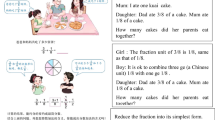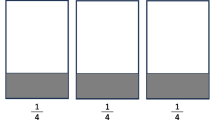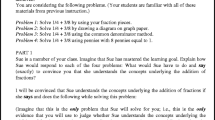Abstract
This paper reports a study of the efficacy of Learning Mathematics through Representations (LMR), an innovative curriculum unit designed to support upper elementary students’ understandings of integers and fractions. The unit supports an integrated treatment of integers and fractions through (a) the use of the number line as a cross-domain representational context, and (b) the building of mathematical definitions in classroom communities that become resources to support student argumentation, generalization, and problem solving. In the efficacy study, fourth and fifth grade teachers employing the same district curriculum (Everyday Mathematics) were matched on background indicators and then assigned to either the LMR experimental classrooms (n = 11) or the comparison group (n = 8 with 10 classrooms). During the fall semester, LMR teachers implemented the LMR unit on 19 days and district curriculum on other days of mathematics instruction. HLM analyses documented greater achievement for LMR students than Comparison students on both the end-of-unit and the end-of year assessments of integers and fractions knowledge; the growth rates of LMR students were similar regardless of entering ability level, and gains for LMR students occurred on item types that included number line representations and those that did not. The findings point to the efficacy of the LMR sequence in supporting teaching and learning in the domains of integers and fractions.













Similar content being viewed by others
Notes
Two teachers taught mathematics to two classrooms.
Two LMR teachers participated in the process of the curriculum’s iterative refinement. Though these two teachers (LMR-familiar) were more familiar with the LMR lessons than the other LMR teachers (LMR-new), analyses based on three participating groups (LMR-familiar, LMR-new, and Comparison) revealed that student learning gains in the LMR-familiar classrooms were not statistically different from gains in the LMR-new classrooms and indeed fell well within the range of the gains in other classrooms. We therefore included these two teachers in the LMR group for purposes of our efficacy analyses.
We calculated the demographic statistics on 90 % of the participating students. We did not have access to this information for the remaining students.
See the Appendix for greater detail on the measurement and longitudinal models.
If we compare these findings to the pooled standard deviation of the test scores at pretest (1.2 logits), the differences between LMR and Comparison students were 1.3 and 0.7 pretest standard deviations at posttest and final test, respectively.
Students in the Low pretest score group showed the most growth on the Integers subscale during the Integers lessons, and students in the Middle pretest score group showed the most growth on the Fractions subscale during the Fractions lessons.
A random coefficient for the change from pretest to interim test was not included in the final model because its estimated variance was very close to zero and its inclusion did not improve overall model fit.
As in the first model, a random coefficient for the change from pretest to interim test was not included in the final model.
References
Adams, R. J., Wilson, M., & Wang, W. C. (1997). The multidimensional random coefficients multinomial logit model. Applied Psychological Measurement, 21(1), 1–23.
Andersen, E. B. (1985). Estimating latent correlations between repeated testings. Psychometrika, 50, 3–16.
Baldwin, J., & Kessel, C. (1999). Concept and computation: the role of curriculum. Mathematics and Education Reform Forum, 12(1), 4–5.
Barrett, J. E., & Clements, D. H. (2003). Quantifying path length: fourth-grade children’s developing abstractions for linear measurement. Cognition and Instruction, 21(4), 475–520.
Bastable, V., Murray, M., Bloomfield, K., Russell, S. J., Schifter, D., Cochran, K., et al. (2012). Investigations in number, data, and space. Glenview: Scott Foresman.
Behr, M. J., Harel, G., Post, T., & Lesh, R. (1994a). Units of quantity: a conceptual basis common to additive and multiplicative structures. In G. Harel & J. Confrey (Eds.), The development of multiplicative reasoning in the learning of mathematics (pp. 121–176). Albany: State University of New York Press.
Behr, M. J., Harel, G., Post, T., & Lesh, R. (1994b). Units of quantity: a conceptual basis common to additive and multiplicative structures. In G. Harel & J. Confrey (Eds.), The development of multiplicative reasoning in the learning of mathematics (pp. 123–180). Albany: SUNY Press.
Bright, G., Behr, M., Post, T., & Wachsmuth, I. (1988). Identifying fractions on number lines. Journal for Research in Mathematics Education, 19(3), 215–232.
Bruno, A., & Martinon, A. (1999). The teaching of numerical extensions: the case of negative numbers. International Journal of Mathematical Education in Science and Technology, 30(6), 789–809.
Clements, D. H. (2007). Curriculum research: toward a framework for “research-based curricula”. Journal for Research in Mathematics Education, 38(1), 35–70.
Cobb, P., Confrey, J., diSessa, A., Lehrer, R., & Schauble, L. (2003). Design experiments in educational research. Educational Researcher, 32(1), 9–13.
Cobb, P., & Gravemeijer, K. (2008). Experimenting to support and understand learning processes. In A. E. Kelly, R. Lesh, & J. Y. Baek (Eds.), Handbook of design research methods in education: Innovations in science, technology, engineering, and mathematics learning and teaching (pp. 68–95). London: Routledge.
Core State Standards Initiative (2010). The Standards: Mathematics. Common Core State Standards Initiative. http://www.corestandards.org/the-standards/mathematics.
Corwin, R. B., & TERC (1991). Seeing fractions: A unit for the upper elementary grades. Sacramento, California.
Davydov, V. V., & Tsvetkovich, Z. H. (1991). On the objective origin of the concept of fractions. Focus on Learning Problems in Mathematics, 13(1), 13–64.
Fosnot, C. T., Dolk, M., Cameron, A., & Hersch, S. (2004). Young mathematicians at work: Professional development materials. Portsmough: Heinemann Press.
Gearhart, M., & Saxe, G. B. (2012). Differentiated instruction in shared mathematical contexts. Teaching Children Mathematics (in press).
Izsak, A., Tillema, E., & Tunc-Pekkan, Z. (2008). Teaching and learning fraction addition on number lines. Journal for Research in Mathematics Education, 39(1), 33–62.
Kennedy, P. A. (2000). Concrete representation and number line models: connecting and extending. Journal of Developmental Education, 24(2), 2–8.
Kleiman, G. M., & Bjork, E. D. (1991). My travels with Gulliver. Scotts Valley: Wings for Learning.
Klein, A. S., Beishuizen, M., & Treffers, A. (1998). The empty number line in Dutch second grades: realistic versus gradual program design. Journal for Research in Mathematics Education, 29, 443–464.
Lehrer, R. (2003). Developing understanding of measurement. In J. Kilpatrick, W. G. Martin, & D. E. Schifter (Eds.), A research companion to Principles and Standards for School Mathematics (pp. 179–192). Reston: National Council of Teachers of Mathematics.
Lehrer, R., & Schauble, L. (2004). Modeling natural variation through distribution. American Educational Research Journal, 41(3), 635–679.
Mack, N. K. (1995). Confounding whole-number and fraction concepts when building on informal knowledge. Journal for Research in Mathematics Education, 26(5), 422–441.
Meyer, M. R., Dekker, T., & Eade, F. (2010). Cross-national curriculum collaboration: Examples based on realistic mathematics education. In B. J. Reys, R. E. Reys, & R. Rubenstein (Eds.), Mathematics curriculum: Issues, trends, and future directions (pp. 145–156). Reston: National Council of Teachers of Mathematics.
Murata, A. (2008). Mathematics teaching and learning as a mediating process: the case of tape diagrams. Mathematical Thinking and Learning, 10, 374–406.
National Center for Education Statistics. (2009). The Nation’s Report Card: Mathematics 2009 (NCES 2010–451). Washington: Institute of Education Sciences.
National Council of Teachers of Mathematics. (2006). Curriculum focal points for prekindergarten through grade 8 mathematics: A quest for coherence. Reston: Author.
National Mathematics Advisory Panel. (2008). The final report of the national mathematics advisory panel: Foundations for success. Washington: U.S. Department of Education.
Pastor, D. A., & Beretvas, S. N. (2006). Longitudinal Rasch modeling in the context of psychotherapy outcomes assessment. Applied Psychological Measurement, 30(2), 100–120.
Petitto, A. L. (1990). Development of number line and measurement concepts. Cognition and Instruction, 7(1), 55–78.
Piaget, J. (1968). Quantification, conservation, and nativism. Science, 162(3857), 976–979.
Piaget, J., Inhelder, B., & Szeminska, A. (1960). The child’s conception of geometry (Trans: Lunzer, E.A.). New York: Basic Books.
R Development Corp Team. (2012). R: A language and environment for statistical computing. Vienna: R Foundation for Statistical Computing.
Ramani, G. B., & Siegler, R. S. (2011). Reducing the gap in numerical knowledge between low- and middle-income preschoolers. Journal of Applied Developmental Psychology, 32(3), 146–159.
Raudenbush, S., & Bryk, A. (2002). Hierarchical linear models: Applications and data analysis methods. Thousand Oaks: Sage.
Saxe, G. B., Earnest, D., Sitabkhan, Y., Haldar, L. C., Lewis, K. E., & Zheng, Y. (2010). Supporting generative thinking about the integer number line in elementary mathematics. Cognition & Instruction, 28(4), 433–474.
Saxe, G. B., Shaughnessy, M. M., Gearhart, M., & Haldar, L. C. (2012) Coordinating numerical and linear units: Elementary students’ strategies for locating whole numbers on the number line. Mathematics Teaching and Learning (in press).
Saxe, G. B., Shaughnessy, M. M., Shannon, A., Langer-Osuna, J., Chinn, R., & Gearhart, M. (2007). Learning about fractions as points on a number line NCTM Yearbook. Reston: NCTM.
Saxe, G. B., Taylor, E. V., McIntosh, C., & Gearhart, M. (2005). Representing fractions with standard notation: A developmental analysis. Journal for Research in Mathematics Education, 36(2), 137–157.
Schmidt, W. H., Whan, H. C., & McKnight, C. C. (2005). Curriculum coherence: an examination of US mathematics and science content standards from an international perspective. Journal of Curriculum Studies, 37(5), 525–559.
Schwarz, B. B., Kohn, A. S., & Resnick, L. B. (1993). Positives about negatives: a case study of an intermediate model for signed numbers. Journal of the Learning Sciences, 3, 37–92.
Selter, C. (1998). Building on children’s mathematics: a teaching experiment in grade three. Educational Studies in Mathematics, 36(1), 1–27.
Siegler, R. S., & Ramani, G. B. (2009). Playing linear number board games—but not circular ones—improves low-income preschoolers’ numerical understanding. Journal of Educational Psychology, 101(3), 545–560.
StataCorp. (2011). Stata Statistical Software: Release 12. College Station: StataCorp LP.
Stigler, J. W., Gonzales, P., Kawanaka, T., Knoll, S., & Serrano, A. (1999). The TIMSS videotape classroom study: Methods and findings from an exploratory research project on eighth-grade mathematics instruction in Germany, Japan, and the United States. Washington: U.S. Department of Education. National Center for Education Statistics.
University of Chicago School Mathematics Project (2007). Everyday Mathematics (Third edition ed.): New York: McGraw-Hill Education.
Warm, T. A. (1989). Weighted likelihood estimation of ability in item response theory. Psychometrika, 54, 427–450.
Watanabe, T. (2007). Initial treatment of fractions in Japanese textbooks. Focus on Learning Problems in Mathematics, 29(2), 41–60.
Watanabe, T., Takahasi, A., & Yoshida, M. (2010). Supporting focused and cohesive curricula through visual representations: An example from Japanese textbooks. In B. J. Reys, R. E. Reys, & R. Rubenstein (Eds.), Mathematics curriculum: Issues, trends, and future directions (pp. 131–144). Reston: National Council of Teachers of Mathematics.
What Works Clearinghouse. (2010a). Developing effective fractions instruction for kindergarten through 8th grade (No. NCEE 2010-4039). Washington: U.S. Department of Education.
What Works Clearinghouse. (2010b). Everyday Mathematics: WWC intervention report. Washington: U.S. Department of Education.
Wilson, M., Zheng, X., & McGuire, L. W. (2012). Formulating latent growth using an explanatory item response model approach. Journal of Applied Measurement, 13(1), 1–22.
Wu, H. (2008). Fractions, decimals, and rational numbers. University of California, Berkeley. http://math.berkeley.edu/~wu/NMPfractions4.pdf. Accessed 23 July 2012.
Wu, M. L., Adams, R. J., Wilson, M. R., & Haldane, S. A. (2007). ACER ConQuest: Version 2.0. Victoria: ACER Press.
Yackel, E., & Cobb, P. (1996). Sociomathematical norms, argumentation, and authonmy in mathematics. Journal for Research in Mathematics Education, 27(4), 458–477.
Acknowledgments
The research reported here was supported in part by the Institute of Education Sciences grant R305B070299 and R305B090026 to UC Berkeley. The opinions expressed are those of the authors and do not represent views of the Institute of Education Sciences or the U.S. Department of Education. We are grateful to the participating teachers and students and to the many contributors to the project. Rick Kleine and Jenn Pfotenhauer served as collaborating teachers in the development of the lesson sequence. A team of doctoral students contributed to the research and to curriculum development: Darrell Earnest, Lina Chopra Haldar, Bona Kang, Katherine Lewis, and Yasmin Sitabkhan. Additional contributors include Nicole Leveille Buchanan, Jennifer Collett, Kenton de Kirby, David Torres Irribarra, Marie Le, Amanda McKerracher, Meghan Shaughnessy, Alison Miller Singley, Josh Sussman, and Ying Zheng. We are grateful to Professors Deborah Loewenberg Ball and Hyman Bass for feedback on the curriculum. Email correspondence: saxe@berkeley.edu.
Author information
Authors and Affiliations
Corresponding author
Appendix
Appendix
1.1 Measurement model
The measurement model used to obtain student ability estimates is given by:
where \( X_{sti} \) indicates the response of student s at time t is for item i, \( \theta_{st} \) is the person and time specific ability, and \( \delta_{i} \) is the item difficulty. The \( \varvec{\theta}_{s} \) are assumed to follow a multivariate normal distribution with unrestricted covariance matrix. All measurement models were fit using ConQuest (Wu, Adams, Wilson, & Haldane, 2007). Table 5 contains the estimated correlation matrix between the assessments at the four occasions for the overall scale.
1.2 Longitudinal growth models
Three longitudinal growth models were estimated using Stata12 (StataCorp. 2011) and graphed using R (R Development Corp Team, 2012).
1.2.1 Model 1
The first model, used for the overall comparison between LMR and Comparison students, is specified in three levels as follows:
Level 1:
Level 2:
Level 3:
\( wle_{tsc} \) is the WLE estimate of overall student ability for student s in classroom c at time t and \( inter_{tsc} \), \( post_{tsc} \), and \( final_{tsc} \) are indicators for test occasion. \( comp_{c} \) is an indicator for classroom c being in the comparison group. \( \zeta_{c} \) is a random classroom-level effect assumed to follow a normal distribution. The \( \zeta_{sc} \) are student-level random effects assumed to follow a multivariate normal distribution with unrestricted covariance matrix.Footnote 7 \( \varepsilon_{tsc} \) is a time-specific error assumed to follow a normal distribution.
Table 6 gives the estimated variance components from fitting this model to the data. Table 1 in the text gives a subset of the estimated parameters (and their linear combinations). Figure 9 was drawn using estimates from this model.
1.2.2 Model 2
The second model extends the first model to include ability estimates for all subscales as the response variable and indicator variables for the four subscales (with the overall scale as the reference category), as follows:
Level 1:
Level 2:
Level 3:
\( wle_{tsc} \) is the WLE estimate of overall student ability for student s in classroom c at time t, \( inter_{tsc} \), \( post_{tsc} \), and \( final_{tsc} \) are indicators for test occasion, and \( integers_{tsc} \), \( fractions_{tsc} \), \( line_{tsc} \), and \( noline_{tsc} \) are indicators for subscale. \( comp_{c} \) is an indicator for classroom c being in the comparison group. \( \zeta_{c} \) is a random classroom-level effect assumed to follow a normal distribution. The student-level random effects \( \zeta_{sc} \) are assumed to follow a multivariate normal distribution with unrestricted covariance matrix. \( \varepsilon_{tsc} \) is a time-specific error assumed to follow a normal distribution.
Table 7 presents the estimated variance components from fitting this model to the data. Tables 2, 3, and 4 (in the text) contain a subset of the estimated parameters (and their linear combinations). Figures 11 and 13 are drawn using estimates from this model.
1.2.3 Model 3
The third model extends the first model to include indicator variables for student pretest score group (with the low group as the reference category), as follows:
Level 1:
Level 2:
Level 3:
\( wle_{tsc} \) is the WLE estimate of student achievement on the scale of interest for student s in classroom c at time t; this model was fit using the overall subscale and then the integers and fractions subscales as the dependent variable. \( inter_{tsc} \), \( post_{tsc} \), and \( final_{tsc} \) are indicators for test occasion. \( med_{sc} \) and \( high_{sc} \) are indicator variables for a student being in the medium or high pretest score group, respectively. \( comp_{c} \) is an indicator for classroom c being in the comparison group. \( \zeta_{c} \) is a random classroom-level effect assumed to follow a normal distribution. The \( \zeta_{sc} \) are student-level random effects assumed to follow a multivariate normal distribution with unrestricted covariance matrix.Footnote 8 \( \varepsilon_{tsc} \) is a time-specific error assumed to follow a normal distribution.
Table 8 gives the estimated variance components from fitting this model to the data. Figures 10 and 12 are drawn using estimates from this model.
Rights and permissions
About this article
Cite this article
Saxe, G.B., Diakow, R. & Gearhart, M. Towards curricular coherence in integers and fractions: a study of the efficacy of a lesson sequence that uses the number line as the principal representational context. ZDM Mathematics Education 45, 343–364 (2013). https://doi.org/10.1007/s11858-012-0466-2
Accepted:
Published:
Issue Date:
DOI: https://doi.org/10.1007/s11858-012-0466-2




